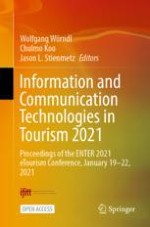The findings illustrate the richness of data about ongoing travel search readily available through Pinterest, demonstrate the flexibility of netnography in terms of zooming in and out of data to explore insights at different levels, discuss how the platform shapes travel dreams, and present commonalities and differences across Pinners and boards.
4.1 Descriptive Analysis of Pinterest Boards
As mentioned above, 100 “Places I’d Like to Go” boards on Pinterest were analyzed in terms of their characteristics and top row contents. The results of the descriptive analysis indicate that there is diversity in the boards but also suggest some interesting trends. They further hint at methodological challenges for automated types of analysis.
Despite these difficulties, some interesting results emerged, even for high-level coding at the continent level. First, no pins displayed in the first row of the board related to destinations in Antarctica and five pins each were located in Africa and in the Middle East. Most surprisingly, only 9 boards displayed destinations in the Pacific, although Australia, New Zealand and the South Pacific island nations often fill the pages of travel magazines and are generally considered as highly aspirational destinations. Central & South America were only present in 11% of the boards (16 pins in total) and 19% of the boards displayed an Asian destination in their first row. Europe and North America clearly dominated the boards, with 63% of boards featuring at least one European destination and 71% showing at least one pin from North America in their top row.
While the analyzed pins represent the most recent pins for each board, the actual date the pin was added is not displayed. The platform has a new option to add date ranges to boards, but users (including the author) do not seem to limit their “Places I’d Like to Go” boards to specific time periods, confirming the ongoing nature of their efforts. Thus, while there is some indication that recent pins do not include many exotic destinations, a direct link to the COVID-19 pandemic cannot be made. Only two pins directly spoke to travel restrictions: one featured the best virtual tours around the world and was labeled “Can’t travel?”, while the other presented “family staycation” ideas for spring break. Most rows (56%) displayed pins from more than one continent, suggesting that the travel dreams of Pinners generally involve at least some long-haul travel.
As described in the methodology section, the coding of the contents further involved the identification of easily detectable features that speak to the types of destinations or vacations Pinners dream about. Only one board did not have any of the coded features in its top row. What stands out is that 90% of the analyzed boards display at least one image with a water-related feature. In contrast, only five of all analyzed pins contain animals. Equally rare to find were churches and temples. Surprisingly, while the “sea” portion of the “sea, sand and sun” vacation stereotype appeared prominently across the boards, only 42% of the boards displayed an image of a beach and 28% even showed snow or ice. Mountains and cityscapes were equally popular, with 39% of boards including at least one respective image. A small number of pins (27 in total) spread over 19% of the boards related to food.
Other categories that emerged but were not specifically coded include general “bucket lists” or more specific “best places in X” lists, hinting at the role of these boards in providing inspiration at various levels. Further, quite a few images related to specific hotels, restaurants or attractions, suggesting that Pinners do not just dream of destinations in the sense of geographic locations. Moreover, maps that displayed itineraries or clusters of attractions were included in several of the boards, indicating that Pinterest boards are used to archive information that directly helps with later travel planning.
4.2 In-Depth Analysis
The four boards selected to represent the in-depth analysis display a broad range in terms of their structure, size, popularity and contents. They provide diverse content types and describe travel dreams at different levels of specificity. They illustrate what contextual information can be easily derived through qualitative analysis of boards and what insights are possible in terms of the ways different Pinners go about structuring their ongoing travel searches.
Table 1.
Laura’s “Places I’d Like to Go” Board Sections.
Nicaragua | 1 | Kona Hawaii | 12 |
Guatemala | 3 | Stateside | 17 |
Girls Trip | 3 | Spain + Portugal + Chefchaouen | 31 |
Chile | 2 | Italy | 41 |
Madagascar & Seychelles | 4 | Netherlands and Belgium | 76 |
Amalfi | 2 | Turkey | 172 |
Balkans | 11 | Sicily | 44 |
Sri Lanka travel | 6 | Paris trip | 8 |
Lebanon | 2 | Malta | 43 |
Tahoe trip | 4 | Travel Dreams | 52 |
France | 15 | Cuba Bound | 53 |
Greece | 34 | I dream of Morocco | 67 |
Peru | 8 | Vacation Excitement | 35 |
Travel Wardrobe | 34 | | |
Her “Places I’d Like to Go” board only has 54 pins that are not assigned to any section. They encompass a random collection of pins that discuss when to visit different destinations, what to buy on a trip to Turkey, most iconic hotels in the world, best tapas bars in Seville, things-to-do in Kathmandu, etc.
